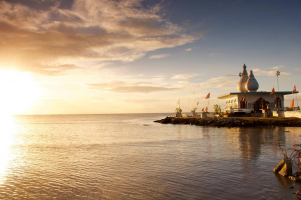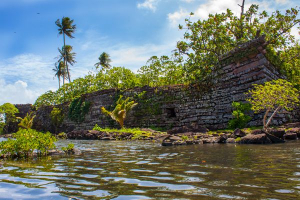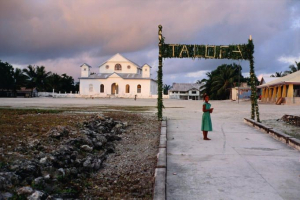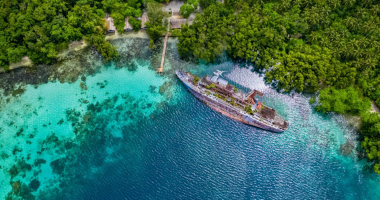Top 10 Most Beautiful Historical Sites in Mauritius
Mauritius, an island nation off the coast of Africa, is a favorite honeymoon destination. Mauritius is a cosmopolitan country with inhabitants of Indian, ... read more...African, French, and Chinese descent. It is known for its beaches, flora and wildlife, and scenic terrain. The island's tropical atmosphere drew Europeans in, making its history remarkable. Between the sixteenth and twentieth centuries, the nation was governed by the Dutch, French, and British. Mauritius has a number of must-see historical sites that can help you better understand the culture of the island. Here are the most beautiful historical sites in Mauritius.
-
Beautiful beaches, crystal blue oceans and lagoons, nature adventures, shopping havens, and lively nightlife may be all that Mauritius has to offer for some. True, all of this contributes to Mauritius's status as a fantastic tourist location. It would be a sin, however, if we ignored the historical treasures that the area has to offer, one of which being the magnificent Balaclava Ruins, which are engulfed by the traditional Maritim Resort and Spa on the Turtle Bay beach. Every place has its own history that influences a visitor's viewpoint and experience of that location, and Mauritius is no exception.
Mauritius was colonized by the French in the 18th century. The government was shifted from Mahebourg in the south to the north by the first governor, Mahe de Labourdonnais. In honor of King Louis XV, the new capital was named Port Louis. The new capital and its dock were constructed with iron from neighboring Balaclava. During Mahe de Labourdonnais' campaigns in India, it was also utilized to create firearms and gun powder. The 'fort' was finished with an iron foundry, a naval arsenal, and a gun powder plant.
Between all of this, in the mid-eighties, an English admiral named Boscawen sailed into Turtle Bay and attempted to take over Mauritius. Then, in 1774, the powder storage blew up! The flour mill sawmill and the building where the ironwork was housed were all spared, which was fortunate. The estate was sold to a Mr. Wiehe in 1864. He constructed a gorgeous residence named 'Mon Desir' as well as a school for his workers' children. For a time, the site was a favorite vacation retreat for rich Mauritanians. Mr. Wiehe also constructed a new rum distillery at the time.
Location: Turtle Bay, Balaclava, Mauritius

Source: mauritiusinsideout 
Source: just-mauritius.co.za -
St. Aubin House is one of the most beautiful historical sites in Mauritius goes back to 1819. It was initially located next to the factory but was relocated in the 1970s to give its owner a more peaceful night's sleep. The estate no longer produces sugar, but there is a historic rum distillery and a nursery cultivating anthurium flowers and vanilla on the house's grounds.
Visitors to this historic 19th-century mansion will get a real experience of colonial life while sipping powerful rum. The plantation, which was built in 1819 from the wood of disassembled ships, is a tribute to a life in Mauritius that no longer exists. The restaurant situated inside the historic mansion serves traditional island food, and guests may spend an evening at the Creole-style Saint Aubin Inn. Relax in the pool, ride a horse around the well-kept gardens, or cycle through the plantation.
Tours of the ancient sugar mill and vanilla house are also offered, allowing visitors to observe how two of America's tastiest treats were prepared in the 1800s. The Artisanal Distillery, where tourists may discover how sugar is turned into smooth sips of light, amber, and black rum, is undoubtedly the most popular stop on a visit to Saint Aubin Sugar Plantation. Lunch at the extremely lovely table d'hôte in the main manor home is the pinnacle of the St Aubin experience. Dainty chandeliers shed ambient light over white tablecloths and old wooden furniture in the dining area, which is one of the loveliest throwbacks to colonial times. Hearts of palm, pineapple, mango, and chili, to mention a few, are among the fruits of the plantation included on the set menu.
Location: the southern coast of Mauritius

Source: pinkmango 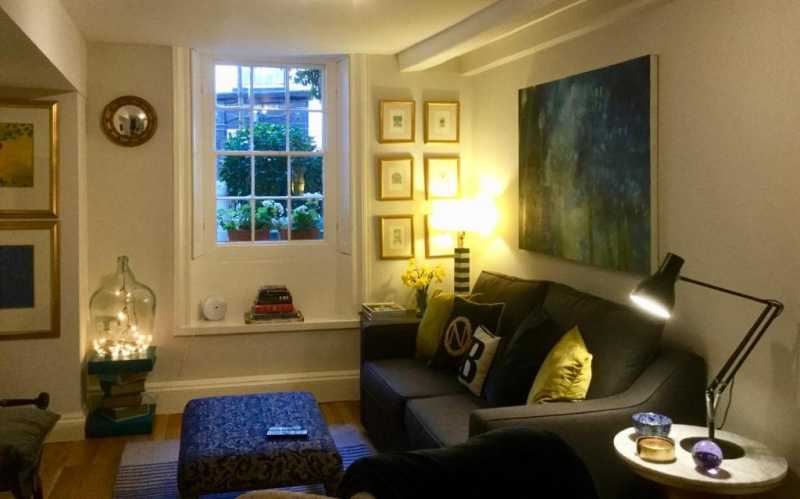
Source: booking.com -
Three of the five Martello Towers erected by the British between 1832 and 1835 at Grand River North West, Black River, and Port Louis have survived. The British chose to construct five Martello Towers along Mauritius' west coast as a coastal defense building in the event of an invasion by the French, who were displeased with the British desire to abolish slavery at the time.
One was discovered in Tamarin, another in L'Harmonie (now a national monument), one in la Preneuse, one in Fort Victoria, and the last one, Cunningham's Tower. The Martello Towers never took part in any military operations. Between 1880 and 1902, the Cunningham Tower vanished, and information regarding the tower at Fort Victoria was last documented in 1880. According to oral histories, the Tamarin tower was abandoned in the 1930s and the site was strewn with cannon balls.
Towers 3, 4, and 5 are still standing. Cunningham Tower was built to defend Fort George from the sides and rear while it was being built. It was decommissioned around 1921, although it was remarkable in that it featured three cannons when the rest of the towers only had one since most Martello Towers were designed to offer 360-degree coverage. In addition, Tower 1 was substantially bigger. Tower 2 was located in Fort Victoria, which now houses a power plant. The battery's ruins may still be seen, but the Martello Tower has long since vanished.
Location: Black River, Mauritius

Source: mauritiusexplored 
Source: patrimoineenperil.mu -
In 1986, the Eureka House was renovated and presented as a museum to the public. A broad, shaded veranda surrounds the home, which is mostly made of wood. The expansive grounds feature a strange combination of native Mauritian plant life, such as mango trees and palm trees, as well as a waterfall and an English-style garden. Music, art, old maps, Chinese and Indian kitchenware, and strange contraptions like a colonial-era shower are all included at the museum. You will be given a tour of the house as well as its lovely gardens.
The Eureka house is much more than a house and museum; it has evolved into a destination for young and elderly nature enthusiasts alike, with kilometers of hiking trails. Many little waterfalls, indigenous flora, luxuriant vegetation, and uncommon specimens surround the residence. The visitor enters a peaceful and tranquil environment. Nowadays, the Euréka grounds are home to a variety of palm trees, mango trees, and a massive Damaras (Agathis robusta), which is one of Mauritius' most stunning trees. During your guided tour of the gardens, you'll see four beautiful little waterfalls. Water lilies, also known as 'Jacinthe d'eau' or 'bredes songes,' grow naturally along riverbanks.
The'scampi, madame Céré' (name derived from the governor's wife), tilapias, carp, and eels, which may be found in considerable quantities, are all located under the water's surface. The azaleas and camellias, as well as the indigenous ochna from South Africa, may be found farther into the garden. Bois pipe, Bois colophane Bâtard, Bois puant, Bois de Clou, Bois de Pomme, Bois de Fer, Liane à gratter, Mapou, Bois de Rivière, Bois puant, Bois de Clou, Bois de Pomme, Bois de Merle, Bois chenille, Ébénier, Takamaka, etc are some of the endemic plants discovered.
Location: Central Plateau, Mauritius

Source: tripadvisor 
Source: tripadvisor -
Mauritius, a beautiful island with a rich past, never fails to provide you with historical sites to explore and transport you back in time. The Matthew Flinders Monument is one of the island's major attractions. It is located 500 meters west of Baie du Cap on the Baie du Cap beach.
Philippe de la Hausse de la Louviere, President of the Societe de L'Histoire de Mauritius, unveiled the Matthew Flinders Monument, in Baie du Cap on November 6, 2003. The bronze memorial depicts Matthew Flinders' structure in a basic, stonewalled room, complete with a chest, his flute, his beloved cat Trim, and a compass, and is surrounded by a chest, his flute, his beloved cat Trim, and a compass. Madame Szuszanna Szemok is responsible for the monument's design. Air Mauritius aided in the transportation of bronze to the building site.
The Matthew Flinders Monument was dedicated in 2003 to commemorate the 200th anniversary of the arrival of this English cartographer and navigator on the island. His entrance was rather spectacular, as the poor man had no knowledge of the English-French conflict and was promptly imprisoned for a term of six years!
Location: the shore of Baie du Cap of Mauritius
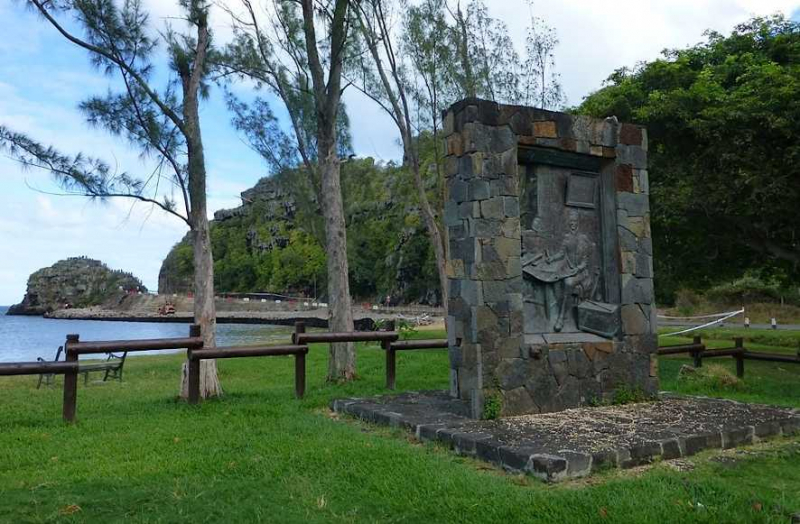
Source: holidify 
Source: wikimedia -
The building of Citadel Fort began on November 11, 1830, and concluded on November 4, 1840, ten years later. It was created in honor of King William IV's wife. Only the Citadel Fort, also known as Fort Adelaide, resisted the French invasion out of the four fortifications erected by the British throughout the nineteenth century. The fort was erected with the intention of fortifying Port Louis' defenses, although it was never utilized for that purpose. It is currently a well-known location for spectacular views of the Capital. The Fort itself is a marvel to behold. The Fort still has certain artifacts from the past, such as cannons, with its wall composed of massive cut stones of basalt rocks.
The Citadel Fort, on the other hand, is currently known for its 360-degree perspective of the Capital. You will enjoy a spectacular view of the Capital from every angle from here! You'll be able to see China Town, the Champ de Mars, and the Alps all from one location. So pack your belongings and bring your camera, because panoramic photographs are a necessity at this location!
Fort Adelaide is a popular weekend destination for residents who come for a quick break or to go running. Because it offers stunning sunset and dawn views, we recommend going during the week to escape the crowds. The small piece of the ancient building will undoubtedly amaze you, so be sure to include it in your itinerary. It is highly recommended that you include it in your Port Louis itinerary.
Location: Port Louis, Mauritius

Source: makemytrip 
Source: holidify -
Aapravasi Ghat (The Immigration Depot) is a building complex in Port Louis, Mauritius, in the Indian Ocean. Mauritius was the first British colony to absorb indentured, or contractual, labor from a variety of nations. Aapravasi Ghat is a literal Hindi translation of "Immigration Depot," and has been in use since 1987. Ghat literally means "interface," metaphorically signifying a shift between the old life and the new for the entering indentured immigrants. Aapravasi is the Hindi term for "immigrant," while ghat literally means "land-sea interface." The Immigration Depot has also been known by an ancient moniker, the 'Coolie Ghat,' alluding to its use as a pit break for potential plantation laborers, commonly known as coolies.
Between 1849 and 1923, half a million Indian indentured laborers went through the Immigration Depot on their way to British Empire plantations. The massive influx of laborers left an indelible effect on the communities of many former British colonies, with Indians accounting for a significant percentage of their populations. In Mauritius alone, Indian origin makes up about 68 percent of the population. As a result, the Immigration Depot has become a significant landmark in Mauritius' history and cultural identity.
Only the incomplete ruins of three stone structures from the entire complex have survived due to unchecked infrastructure development in the mid-20th century. Under Mauritian national heritage legislation, these are now classified as national monuments. In 2006, UNESCO designated the Immigration Depot as a World Heritage Site, recognizing its significance in social history. The Aapravasi Ghat Trust Fund is in charge of the site's management. The fragile structures are being restored to their 1860s status through conservation initiatives. Along with Le Morne Brabant, it is one of Mauritius' two World Heritage Sites.
Location: Port Louis District, Mauritius
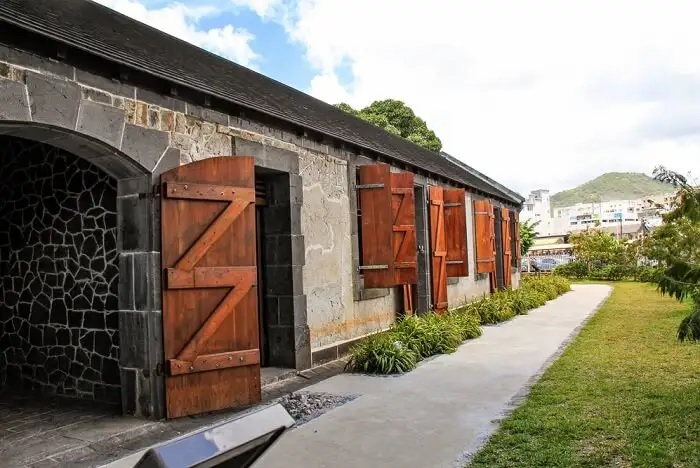
Source: traveltriangle 
Source: pinterest -
Chateau de Labourdonnais, a great Creole palace built in the 1800s and originally owned by Christian Wiehe and his family, has been rebuilt and is now used as a historical tourist destination. The Chateau de Labourdonnais, built completely of teak and featuring a dual-colonnaded gallery, has a clearly neoclassical air to it, while the outside, as well as the interiors of the home, have a very Victorian feel to it. Despite the renovations and updated interiors, the structure still has an ancient air about it. Guided tours of the building begin with stops in various rooms (all of the historic furniture has been preserved) before moving on to the old orchards and beautiful green gardens, where you may stroll amid the well-kept exotic plants and bushes.
Several huge tortoises may be found in the gardens. The trip concludes with a visit to the nearby distillery, where you can learn about agricultural rum's history and various manufacturing processes. You may try the rum at the tasting bar, or you can try the locally produced juices, jams, jellies, and sorbets if you don't want to drink. A boutique and souvenir store are also located at the Chateau de Labourdonnais, where you may purchase locally created handicrafts and items to give to your family and friends.
Location: Pamplemousses, Mauritius

Source: deals.mu 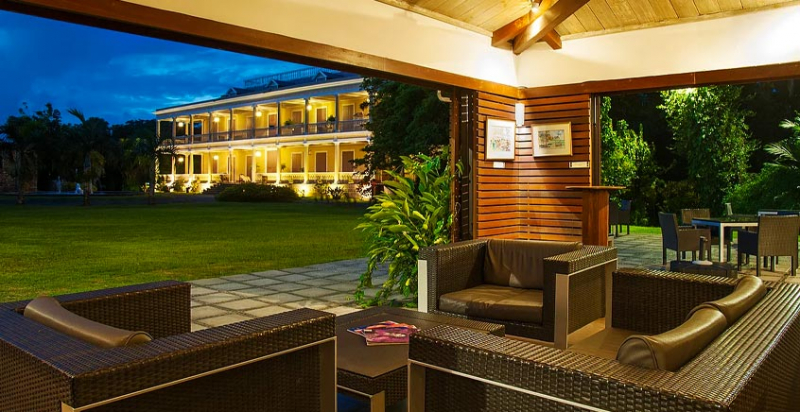
Source: deals.mu -
The Notre Dame Auxiliatrice, located near Cap Malheureux, is one of the oldest churches on the island, having seen one of the most well-documented fights between the French and the British for possession of the island. It was constructed as a memorial to the shipwrecks that occurred off the northern shore. It's also known as "the red roof chapel," and it's notable for both its beauty and historical significance. The church, with its vivid red roof, is a one-of-a-kind and postcard-worthy site in Mauritius. This place is definitely one of the most beautiful historical sites in Mauritius.
Because of its basic construction and subdued color schemes, the chapel stands out among the other churches on the island. This Roman Catholic Church, which was built in the 1900s, continues to attract as many visitors as worshipers. The Notre Dame Auxiliatrice Chapel, dedicated to the Virgin Mary, also has a lovely tiny beach directly behind its main edifice. The church has a large number of newlywed couples, as well as a beautiful choir that is well-known around the country. If you're in the northern portion of Mauritius, the church is a must-see.
Location: Cap Malheureux, Mauritius
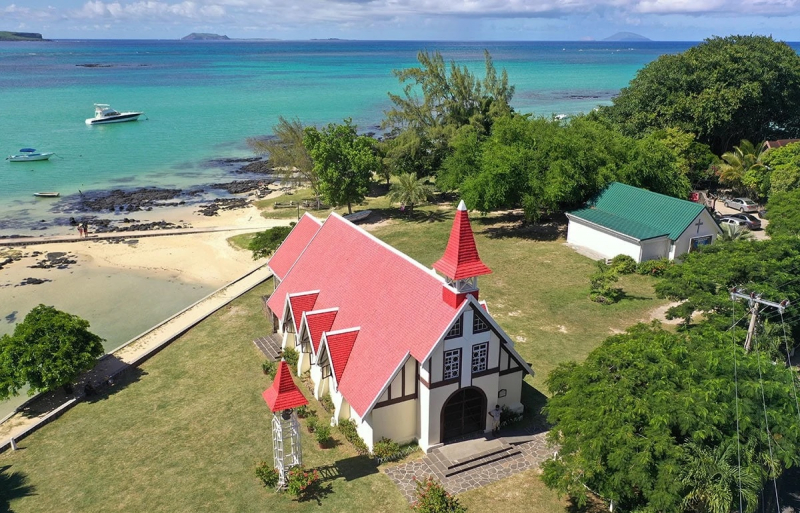
Source: one-million-places.com 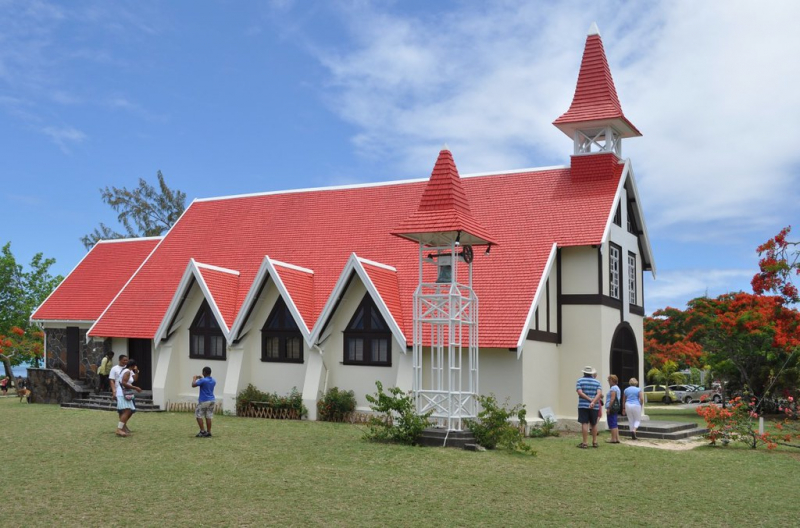
Source: flickr.com -
The SSR Memorial Centre For Culture, located near the commercial center of Port Louis, is an old wooden building that was acquired by the Government of Mauritius in 1986. It is significant because it is where Sir Seewoosagur Ramgoolam spent nearly 30 years of his life, roughly between 1935 and 1965. It was opened on his birthday, September 18th, 1987, by Sir Anerood Jugnauth, then Prime Minister of Mauritius, in the presence of Governor-General Sir Veerasamy Ringadoo, Minister of Education, Arts and Culture Armoogum Parsuramen, and Dr. Navinchadra Ramgoolam.
The SSR Memorial Centre for Culture is dedicated to Sir Seewoosagur Ramgoolam in honor of his crucial contribution as the architect of Mauritius' independence and his status as the country's Father of the Nation. The 150-year-old complex is a living reflection of Mauritius' historical and architectural legacy, rich in symbolism and history. From his birth in 1886 until 1916, it was also the home of Dr. Maurice Cure, the founder of the Mauritius Labour Party. It was designated as a National Monument in 1986, and it is currently recognized as part of Mauritius' National Heritage.
Location: Plaine Verte, Port Louis, Mauritius

Source: holidify 
Source: mainlymauritius













